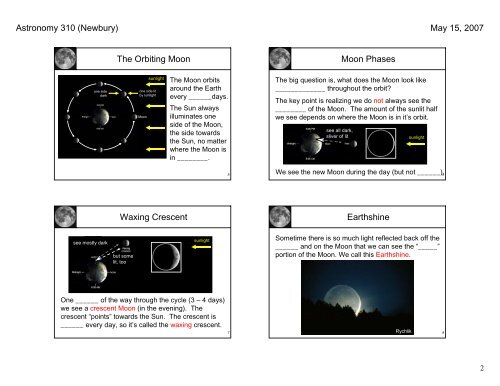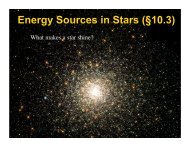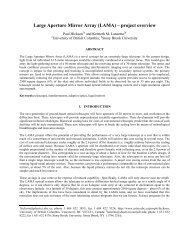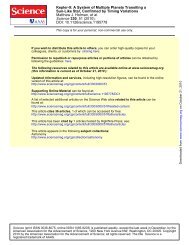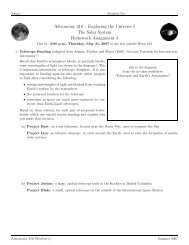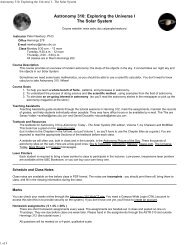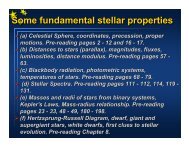The Motion of the Moon The Moon The Earth, Sun, and Time of Day
The Motion of the Moon The Moon The Earth, Sun, and Time of Day
The Motion of the Moon The Moon The Earth, Sun, and Time of Day
- No tags were found...
You also want an ePaper? Increase the reach of your titles
YUMPU automatically turns print PDFs into web optimized ePapers that Google loves.
Astronomy 310 (Newbury)<br />
May 15, 2007<br />
<strong>The</strong> Orbiting <strong>Moon</strong><br />
<strong>Moon</strong> Phases<br />
one side<br />
dark<br />
sunlight<br />
one side lit<br />
by sunlight<br />
<strong>Moon</strong><br />
<strong>The</strong> <strong>Moon</strong> orbits<br />
around <strong>the</strong> <strong>Earth</strong><br />
every ______days.<br />
<strong>The</strong> <strong>Sun</strong> always<br />
illuminates one<br />
side <strong>of</strong> <strong>the</strong> <strong>Moon</strong>,<br />
<strong>the</strong> side towards<br />
<strong>the</strong> <strong>Sun</strong>, no matter<br />
where <strong>the</strong> <strong>Moon</strong> is<br />
in ________.<br />
<strong>The</strong> big question is, what does <strong>the</strong> <strong>Moon</strong> look like<br />
_____________ throughout <strong>the</strong> orbit<br />
<strong>The</strong> key point is realizing we do not always see <strong>the</strong><br />
________ <strong>of</strong> <strong>the</strong> <strong>Moon</strong>. <strong>The</strong> amount <strong>of</strong> <strong>the</strong> sunlit half<br />
we see depends on where <strong>the</strong> <strong>Moon</strong> is in it’s orbit.<br />
see all dark,<br />
sliver <strong>of</strong> lit<br />
sunlight<br />
5<br />
We see <strong>the</strong> new <strong>Moon</strong> during <strong>the</strong> day (but not ______).<br />
6<br />
Waxing Crescent<br />
<strong>Earth</strong>shine<br />
see mostly dark<br />
but some<br />
lit, too<br />
sunlight<br />
Sometime <strong>the</strong>re is so much light reflected back <strong>of</strong>f <strong>the</strong><br />
______ <strong>and</strong> on <strong>the</strong> <strong>Moon</strong> that we can see <strong>the</strong> “_____”<br />
portion <strong>of</strong> <strong>the</strong> <strong>Moon</strong>. We call this <strong>Earth</strong>shine.<br />
One ______ <strong>of</strong> <strong>the</strong> way through <strong>the</strong> cycle (3 – 4 days)<br />
we see a crescent <strong>Moon</strong> (in <strong>the</strong> evening). <strong>The</strong><br />
crescent “points” towards <strong>the</strong> <strong>Sun</strong>. <strong>The</strong> crescent is<br />
______ every day, so it’s called <strong>the</strong> waxing crescent.<br />
7<br />
Rychlik<br />
8<br />
2


